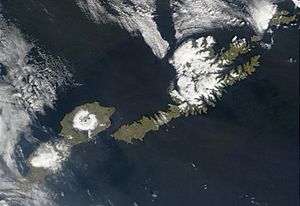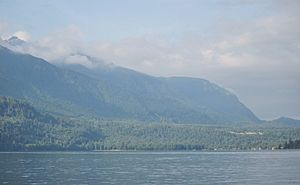Coastrange sculpin facts for kids
Quick facts for kids Coastrange sculpin |
|
|---|---|
 |
|
| A young Coastrange sculpin from Morro Bay, California | |
| Conservation status | |
| Scientific classification | |
| Genus: |
Cottus
|
| Species: |
aleuticus
|
| Synonyms | |
|
|
The Coastrange sculpin (Cottus aleuticus) is a small freshwater fish. It belongs to a group of fish called sculpins. These fish are often found near the ocean in western North America, especially in Canada and the United States. People sometimes call it the Aleutian sculpin.
Contents
About Its Name

The Coastrange sculpin got its official name from a scientist named Charles Henry Gilbert in 1896. He found these fish in streams on Unalaska island in Alaska. Before that, another name, Uranidea microstoma, was used, but it's not clear if it was for the same fish. Another name, Cottus protrusus, was used in 1933, but scientists later found out it was just another name for the Coastrange sculpin. When two names mean the same thing, the older one is usually kept.
What It Looks Like
The Coastrange sculpin has a few special features that help tell it apart from other fish. It has only one small opening (called a pore) under its chin. It also doesn't have teeth on the roof of its mouth. The two fins on its back (called dorsal fins) are very close together, almost touching.
Adult Coastrange sculpins can grow up to 17 centimeters (about 7 inches) long. However, most of them are about 6 centimeters (about 2.5 inches) long. They can live for up to 8 years. Female sculpins that are ready to lay eggs are usually bigger than the males. When it's time to breed, male sculpins turn almost completely black. They also have a small orange edge on their first dorsal fin.
Cultus Lake Sculpins
At Cultus Lake in British Columbia, Canada, there's a special group of Coastrange sculpins. These sculpins are smaller than usual. They live deep in the lake and swim up to the surface at night to find food. Even though they are smaller, these adult sculpins are fully grown. They have larger head pores, which are usually only seen in young sculpins of the main group. Scientists are still trying to understand why this group of sculpins is so different from all the others.
Where It Lives
The Coastrange sculpin lives only along the Pacific coast of North America. You can find them from Bristol Bay and the Aleutian Islands in Alaska, all the way south to Santa Barbara County, California. Sometimes, they are also found in streams further south in Mendocino County. There are also a few groups of these fish living in isolated places. These include the Kobuk River in Alaska, Lake Washington in Washington state, and Cultus Lake in British Columbia.
Coastrange sculpins mostly live in rivers and streams. They prefer areas with fast-moving water (called riffles) or calmer spots (called glides). These areas usually have rocky or pebbly bottoms. The water depth is typically between 0.20 and 1.0 meters (about 8 inches to 3 feet). At night, they move to shallower, calmer water along the edges of the rivers. They often share their homes with other fish like the Prickly sculpin, salmon, and the Three-spined stickleback.
How It Behaves
Coastrange sculpins are usually found alone. They are active at night and are meat-eaters (carnivores). They like to eat young insects like mayflies, stoneflies, and tiny midges. They also eat other small water creatures. Sometimes, they even eat the eggs and tiny young fish (called fry) of pink and chum salmon.
When Coastrange sculpin eggs hatch, the tiny fish (larvae) float freely in the water. They mostly eat very small organisms called plankton. After a while, they start living on the bottom of the water. Then, they eat the same things as adult sculpins, but they choose smaller prey. Coastrange sculpins themselves are sometimes eaten by bigger fish. These include coastal cutthroat trout, coho and sockeye salmon, and Dolly Varden trout.
Spawning and Eggs
Coastrange sculpins usually lay their eggs (spawn) in the spring. This happens when the water temperature goes above 6 degrees Celsius (43 degrees Fahrenheit). However, eggs have been found as early as January in British Columbia. When it's time to spawn, both male and female sculpins swim downstream. They stop just before reaching the salty water of estuaries (where rivers meet the sea).
The male sculpin digs out a nesting spot, usually under a flat rock. He also guards this spot. During courtship, a female swims close to the nest. The male then starts to nod his head, shake, and spread his gill covers. Sometimes his body also wiggles. These movements are not just for show; some of them make a special sound to attract the female. If the male gets her attention, the female will move closer to the nest. The male might then gently bite her on the cheek, side, tail, or fin. He might even take her head into his mouth! If the female is ready to lay eggs, she will always enter the nest after being bitten.
Inside the nest, the female turns upside down and releases her eggs. The male then fertilizes them. One male can mate with several females this way. He might also mate with the same female multiple times.
Coastrange sculpin eggs are yellow to orange. They are laid on the underside of the flat rock that forms the top of the nest. These sculpins don't lay as many eggs as some other types of sculpins. On average, they produce about 1,000 eggs. The young fish (larvae) are active right after they hatch. They then swim further downstream at night. They usually grow in estuaries for about a year before swimming back to freshwater.



